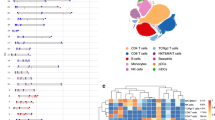Abstract
INSULIN-DEPENDENT diabetes mellitus is widely believed to be an autoimmune disease1. Recent onset diabetics show destruction of insulin-secreting pancreatic β -cells associated with a lymphocytic infiltrate (insulitis) 2, with autoantibodies to β-cells being found even before the onset of symptoms3. Susceptibility to the disease is strongly influenced by major histocompatibility complex (MHC) class II polymorphism in both man4 and experimental animal models such as the non-obese diabetic (NOD) mouse5. As MHC class II molecules are usually associated with dominant immune responsiveness, it was surprising that introduction of a transgenic class II molecule, I–E, protected NOD mice from insulitis and diabetes6. This could be explained by a change either in the target tissue or in the T cells presumed to be involved in β-celI destruction. Recently, several studies have shown that I–E molecules are associated with ontogenetic deletion of T cells bearing antigen/MHC receptors encoded in part by certain T-cell receptor Vβ gene segments7–11. To determine the mechanism of the protective effect of I–E, we have produced cloned CD4+ and CD8+ T-cell lines from islets of recently diabetic NOD mice. These cloned lines are islet-specific and pathogenic in both I–E− and I–E+ mice. Both CD4+ and CD8+ cloned T cells bear receptors encoded by a Vβ5 gene segment, known to be deleted during development in I–E expressing mice10. Our data provide, therefore, an explanation for the puzzling effect of I–E on susceptibility to diabetes in NOD mice.
Similar content being viewed by others
References
Eisenbarth, G. S. New Engl. J. Med. 314, 1360–1368 (1986).
Gepts, W. in Immunology in Diabetes 21–34 (Kimpton, London, 1984).
Strikanta, S., Ganda, O. P., Rabizadeh, A., Soeldner, J. S. & Eisenbarth, G. S. New Engl. J. Med. 313, 461–464 (1985).
Todd, J. A., Bell, J. I. & McDevitt, H. O. Nature 329, 599–604 (1987).
Acha-Orbea, H. & McDevitt, H. O. Proc. natn. Acad. Sci. U.S.A. 84, 2435–2439 (1987).
Nishimoto, H., Kikutani, H., Yamamura, K-i. & Kishimoto, T. Nature 328, 432–434 (1987).
Kappler, J., Roehm, N. & Marrack, P. Cell 49, 273–280 (1987).
Kappler, J., Staerz, U., White, J. & Marrack, P. C. Nature 332, 35–40 (1988).
MacDonald, H. R. et al. Nature 332, 40–45 (1988).
Bill, J., Appel, V. B. & Palmer, E. Proc. natn. Acad. Sci. U.S.A. 85, 9184–9188 (1988).
Bill, J., Kanagawa, O., Woodland, D. L. & Palmer, E. J. exp. Med. 169, 1405–1419 (1989).
Bendelac, A. C., Carnaud, C., Boitard, C. & Bach, J.-F. J. exp. Med. 166, 823–832 (1987).
Wicker, L. S., Miller, B. J. & Mullen, Y. Diabetes 35, 855–860 (1986).
Haskins, K., Portas, M., Bradley, B., Wegman, D. & Lafferty, K. Diabetes 37, 1444–1448 (1988).
Ikegami, H., Makino, S., Harada, M., Eisenbarth, G. S. & Hattori, M. Diabetologia. 31, 254–258 (1988).
Koike, T. et al. Diabetes 36, 539–541 (1987).
Hayward, A. R., Cobbold, S. P., Waldmann, H., Cooke, A. & Simpson, E. J. Autoimmunity 1, 91–96 (1988).
Yagi, J., Baron, J., Buxser, S. & Janeway, C. A. Jr. J. Immunol., in the press.
Janeway, C. A. Jr. et al. Immunol. Rev. 107, 61–88 (1989).
White, J. et al. Cell 56, 27–35 (1988).
Marrack, P. & Kappler, J. Nature 332, 840–843 (1988).
Nerup, J. Adv. metab. Disord. 9, 263–278 (1978).
Kappler, J. et al. Science 244, 811–813 (1989).
Nepom, B. S. et al. J. exp. Med. 164, 345–360 (1986).
Acha-Orbea, H. et al. Cell 54, 263–273 (1988).
Urban, J. L. et al. Cell 54, 577–592 (1988).
Stamenkovic, I. et al. Proc. natn. Acad. Sci. U.S.A. 85, 1179–1183 (1988).
Heber-Katz, E. & Acha-Orbea, H. Immun. Today 10, 164–169 (1989).
Prowse, S. J. et al. in Methods in Diabetes Research Laboratory Methods Vol. 1. 253–269 (Wiley, New York, 1984).
Staerz, U. D., Rammensee, H.-G., Benedetto, J. D. & Bevan, M. J. J. Immun. 134, 3994–3999 (1985).
Author information
Authors and Affiliations
Rights and permissions
About this article
Cite this article
Reich, EP., Sherwin, R., Kanagawa, O. et al. An explanation for the protective effect of the MHC class II I–E molecule in murine diabetes . Nature 341, 326–328 (1989). https://doi.org/10.1038/341326a0
Received:
Accepted:
Issue Date:
DOI: https://doi.org/10.1038/341326a0
- Springer Nature Limited
This article is cited by
-
Non-classical MHC I-E negatively regulates macrophage activation and Th17 cell development in NOD mice
Scientific Reports (2015)
-
Susceptibility to anti-glomerular basement membrane disease is strongly associated with HLA-DRB1 genes
Kidney International (1997)
-
GAD, diabetes, and Stiff-Man syndrome: Some progress and more questions
Journal of Endocrinological Investigation (1994)
-
Immune response to glutamic acid decarboxylase correlates with insulitis in non-obese diabetic mice
Nature (1993)
-
A decrease in the estimated frequency of the extended HLA haplotype B18 CF130 DR3 DQw2 is common to non-insulin-dependent diabetes, juvenile rheumatoid arthritis, and Berger's disease
Experientia (1993)





